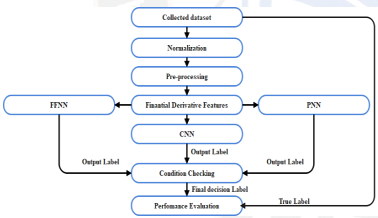Condition based Ensemble Deep Learning and Machine Learning Classification Technique for Integrated Potential Fishing Zone Future Forecasting
Main Article Content
Abstract
Artificial Intelligence (AI) technologies have become a popular application in order to improve the sustainability of smart fisheries. Although the ultimate objective of AI applications is often described as sustainability, there is yet no proof as to how AI contributes to sustainable fisheries. The proper monitoring of the longitudinal delivery of different human impacts on activities such as fishing is a major concern today in aquatic conservation. The term "potential fishing zone" (PFZ) refers to an anticipated area of any given sea where a variety of fish may congregate for some time. The forecast is made based on factors including the sea surface temperature (SST) and the sea superficial chlorophyll attentiveness. Fishing advisories are a by-product of the identification procedure. Normalization and preliminary processing are applied to these unprocessed data. The gathered attributes, together with financial derivatives and geometric features, are then utilised to make projections about IPFZ's Technique are used to get the final determination (CECT). In this study, we offer a technique for identifying and mapping fishing activity. Experimentations are performed to validate the efficacy of the CECT method in comparison to machine learning (ML) and deep learning (DL) methods across a variety of measurable parameters. Results showed that CECT obtained 94% accuracy, while Convolutional neural network only managed 92% accuracy on 80% training data and 20% testing data.
Article Details
References
Bradley, D.; Merrifield, M.; Miller, K.M.; LoMonico, S.; Wilson, J.R.; Gleason, M.G. Opportunities to improve fisheries management through innovative technology and advanced data systems. Fish Fish. 2019, 20, 564–583.
Fosso, K.; Wamba, S.; Bawack, R.; Guthrie, C.; Queiroz, M.; Carillo, K. Are we preparing for a good AI society? A bibliometric review and research agenda. SSRN Electron. J. 2021, 164, 120482.
Peeters, R.; Schuilenburg, M. The Algorithmic Society, Technology, Power, and Knowledge; Routledge: London, UK, 2021.
Ossewaarde, M.; Gulenc, E. National Varieties of Artificial. Computer 2020, 53, 53–61.
Mustafa, F.H. A Review of Smart Fish Farming Systems. J. Aquac. Eng. Fish. Res. 2016, 2, 193–200.
Yang, X.; Zhang, S.; Liu, J.; Gao, Q.; Dong, S.; Zhou, C. Deep learning for smart fish farming: Applications, opportunities and challenges. Rev. Aquac. 2020, 13, 66–90.
Pérez-Ortiz, M.; Fernández-Delgado, M.; Cernadas, E.; Domínguez-Petit, R.; Gutiérrez, P.A.; Hervás-Martínez, C. On the Use of Nominal and Ordinal Classifiers for the Discrimination of States of Development in Fish Oocytes. Neural Process. Lett. 2016, 44, 555–570.
Li, K.; Sidorovskaia, N.A.; Tiemann, C.O. Model-based unsupervised clustering for distinguishing Cuvier’s and Gervais’ beaked whales in acoustic data. Ecol. Inform. 2020, 58, 101094.
Raza, K.; Hong, S. Fast and Accurate Fish Detection Design with Improved YOLO-v3 Model and Transfer Learning. Int. J. Adv. Comput. Sci. Appl. 2020, 11, 7–16.
Labao, A.B.; Naval, P.C. Cascaded deep network systems with linked ensemble components for underwater fish detection in the wild. Ecol. Inform. 2019, 52, 103–121.
Siddiqui, S.A.; Salman, A.; Malik, M.I.; Shafait, F.; Mian, A.; Shortis, M.R.; Harvey, E.S. Automatic fish species classification in underwater videos: Exploiting pre-trained deep neural network models to compensate for limited labelled data. ICES J. Mar. Sci. 2018, 75, 374–389.
Jalal, A.; Salman, A.; Mian, A.; Shortis, M.; Shafait, F. Fish detection and species classification in underwater environments using deep learning with temporal information. Ecol. Inform. 2020, 57, 101088.
Chuaysi, B.; Kiattisin, S. Fishing Vessels Behavior Identification for Combating IUU Fishing: Enable Traceability at Sea. Wirel. Pers. Commun. 2020, 115, 2971–2993.
Kylili, K.; Hadjistassou, C.; Artusi, A. An intelligent way for discerning plastics at the shorelines and the seas. Environ. Sci. Pollut. Res. 2020, 27, 42631–42643.
Cantorna, D.; Dafonte, C.; Iglesias, A.; Arcay, B. Oil spill segmentation in SAR images using convolutional neural networks. A comparative analysis with clustering and logistic regression algorithms. Appl. Soft Comput. 2019, 84, 105716.
Al-Ruzouq, R.; Gibril, M.; Shanableh, A.; Kais, A.; Hamed, O.; Al-Mansoori, S.; Khalil, M. Sensors, Features, and Machine Learning for Oil Spill Detection and Monitoring: A Review. Remote Sens. 2020, 12, 3338.
Song, D.; Zhen, Z.; Wang, B.; Li, X.; Gao, L.; Wang, N.; Xie, T.; Zhang, T. A Novel Marine Oil Spillage Identification Scheme Based on Convolution Neural Network Feature Extraction from Fully Polarimetric SAR Imagery. IEEE Access 2020, 8, 59801–59820.
Liu, S.; Liu, Y.; Alabia, I.D.; Tian, Y.; Ye, Z.; Yu, H.; Li, J.; Cheng, J. Impact of Climate Change on Wintering Ground of Japanese Anchovy (Engraulis japonicus) Using Marine Geospatial Statistics. Front. Mar. Sci. 2020, 7, 1–15.
Cabreira, A.G., Martin Tripode and Adriain Madirolas “Artificial neural networks for fish-species identification, artificial neural networks for fish-species identification”, ICES Journal of Marine Science, Vol.66, pp.1119–1129, 2009.
Rodriguez,N., Orlando Duran “ Multiscale Polynomial Autoregressive Model For Monthly Sardines Catches Forecasting” ,IEEE Fourth International Conference on Computer Sciences and Convergence Information Technology, 1524-1528, 2009.
Shakya,S., Hongchun Yuan, Xinjun Chen and Liming Song “Application of Radial Basis Function Neural Network for Fishery Forecasting”, IEEE, pp.287-291, 2011.
Nurdin, S., Lihan, T. and Mustapha, A.M. “Mapping of Potential Fishing Grounds of Rastrelliger kanagurta (Cuvier, 1816) in the Archipelagic Waters of Spermonde Indonesia Using Satellite Images”, Malaysia Geospatial Forum, Holiday Inn Melaka, pp.6-7, 2012.
Salleh T Daqamseh, Shattri Mansor, Biswajeet Pradhan, Lawal Billa and Ahmad Rodzi Mahmud “Potential fish habitat mapping using MODIS-derived sea surface salinity, temperature and chlorophyll-a data: South China Sea Coastal areas, Malaysia”, Geocarto International, Vol. First article, pp. 1–15, 2012.
Tadjuddah,M., Ahmad Mustafa, Utama K. Pangerang and Farid Yasidi “Application of satellite multi-sensor techniques to detect upwellings and potential fishing grounds in Wakatobi Marine National Park, Southeast Sulawesi, Indonesia.”, Aquatic Ecosystem Health and Management, Vol.15, No.3, pp.303–310, 2012.
Parzen, E., 1962. On estimation of a probability density function and mode. The annals of mathematical statistics, 33(3), pp.1065-1076.
Specht, D. F. (1990). Probabilistic neural networks. Neural networks, 3(1), 109-118.
Rutkowski, D. T., & Kaufman, R. J. (2004). A trip to the ER: coping with stress. Trends in cell biology, 14(1), 20-28.

